
TUSCUMBIA
By L.A. Wright and T.C. Wright, 1933
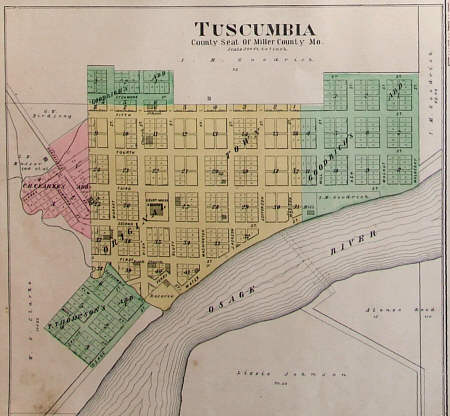 |
The county's first post office was established at Tuscumbia in December 1837 and J.P. Harrison was the first postmaster. The Harrison brothers it seems were enterprising and not only conducted a mercantile business at Tuscumbia, but held public positions. Jesse Kendrick, whose grave is found on the bank of Shut-In Branch, was conducting a store and saloon here in 1838. About 1844 Daniel Cummings built a "mammoth" store building on the bank of Shut-In Branch. The building was of walnut and pine, and most of the lumber was hauled to Tuscumbia from Texas County with teams of oxen. C.P. Davidson was Tuscumbia's first ferryman, and received a permit from the county court in 1837.
W.A. Hackney was operating a store in Tuscumbia during the early sixties, and bushwhackers made a raid on his store during the war. A posse followed the outlaws into another county and secured some of the stolen goods.
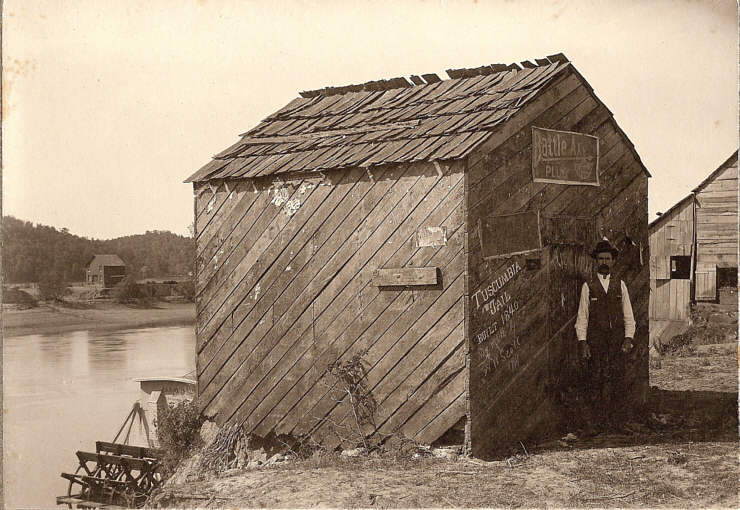
Tuscumbia Jail built in 1840
In 1879 Mrs. Augusta Folsom was conducting a dry goods and grocery store, Mrs. J.P. Wright was milliner, R. VerBryck had charge of the Home Hotel, M. Lesem was engaged in merchandising, and in that year The Vindicator was first published by J.H.D. Tomson and J.P. Wright. The latter continued to publish The Vindicator, then the Eye-Opener for a number of years. E.C. Swalem and Jacob Gantt were attorneys, I.M. Goodrich was a notary public and land agent, having been county and circuit clerk during the Civil War, David Marshall was a notary public, conveyancer, and postmaster and John Kallenbach was blacksmith and wagon-maker. Charles H. Clarke was ferryman. I.T. Johnson and W.C. Brumley conducted a general store and saloon. During the same year M. Lesem sold his store to Louis Lesem, who also acquired the Tuscumbia Mills, then put S.H. Curry, a miller, in charge. Grinding days were Wednesdays, Thursdays, Fridays and Saturday.
In 1883 Charles W. Wells was located at Tuscumbia as an "attorney and counselor at law". T.B. Robinson, who "graduated" from the office of county and circuit clerk, was practicing law and had the only abstract books in the county. John Rhodes was operating the Anchor Mills in 1883.
In 1889, the Anchor Roller Mills and the Str. Frederick, owned by W.H. Hauenstein and R.M. Marshall, were the heaviest enterprises in Tuscumbia. Merchants were Hauenstein & Co., Simpson & Co., and F.W. Fendorf, the last mentioned having first formed a partnership with Louis Lesem, and serving as postmaster during the nineties. Dr. J.B. McGee and I.T. Johnson handled drugs. B.F. Lawson had a grocery. The ferry was owned by I.T. Johnson. Tuscumbia had three hotels then-The Home by Ludwell Bacon, the City Hotel by Mrs. E.A. Freeman, and the Kentucky House by Mrs. J. Bell. John W. Fogelman had a livery barn, and George W. Bacon operated the West Aurora-Tuscumbia mail and passenger hack line. Page Thompson was the shoe cobbler and I.N. Reed the barber. John Kallenbach and John Weitz were blacksmiths and wagon-makers. H.W. Carter was a saddler. Mrs. Carrie Wright was the milliner. P.F. Hauenstein conducted a lumber yard. Charles Fulkerson was photographer. Simpson & Co. were tie contractors. Attorneys were T.B. Robinson, E.C. Swalem, L.N. Musser, and E.C. McIntire. The medical fraternity was represented by Dr. J.B. McGee and Dr. S.W. Ewell.

Part of Main Street. Large building – Tom Robinson’s store later Haynes Bros. Frank Fendorf and others owned it. White building on the left is Hauenstein’s Store. Old open shed dimly seen by it, across the street is Sam Johnson’s store. . Those smaller buildings washed away by flooding Osage River about 1900. George Swanson, postmaster is in the foreground.
Between the years 1890 and 1933 there were many changes in the business roster of Tuscumbia. Among those engaged in the mercantile business here during the years referred to were found H.L. Moles and J.L. Cummings of the T.B. Robinson Mercantile Co., Walter M. and Frank W. Haynes of the Haynes Mercantile Co., A. Reed and Z.S. Livingston, J.L. Blackburn, F.W. Fendorf, F.E. Fendorf, H.L. Wright, W.S. Spearman, J.Z. Spearman, Geo. W. Helton, L.E. Crane, A.M. Schwabe, Charles Wyrick, Lafe Abbett, Jack Thompson, Asa Grady, W.S. Goodrich, J.N. Brockman, and J.A. Roark. G.P. Swanson conducted a hardware store and was at the same time postmaster. Some of those who were engaged in the grocery and café business were Sam Johnson, B.F. Lawson, B.W. Burris, Chas. Messersmith, Oscar Abbett, P.P. Wright, Jos. Shikles, Chas. Moore, A.F. Waddell, and John H. Potts.
Just prior to the advent of the automobile the livery business flourished and in this business the names of J.W. Fogelman, J.I. Johnson, Tobe Adcock and W.J. and W.M. Burris should be included.
During the last few years the following improvements have materialized in the Tuscumbia community: State highways 17 and 52; farm-to-market road E; free steel bridge built by state across the Osage River; electric power line; brick high school building built at a cost of $20,000; regular truck service to St. Louis; a considerable fishing and tourist business, in large part the result of the building of the Bagnell Dam across the Osage River in the west part of the county; Riverside Park with $2000 worth of permanent buildings; several substantial homes; $1000 worth of fencing at cemetery; much better care of the cemetery than in former years; jail built by Miller County at a cost of $15,000; county home for destitute built by the county at a cost of $25,000; improved local and long distance telephone service, the system being owned by the Ozrk Central Telephone Company.
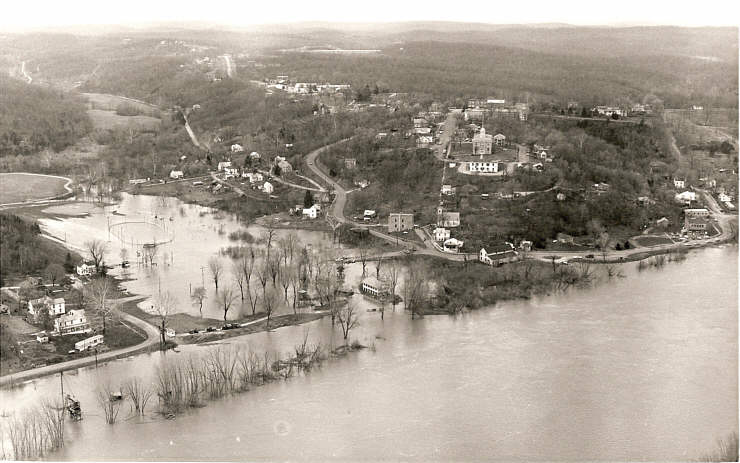
Aerial view of Tuscumbia during the flood of 1973
The following are the lines of business at Tuscumbia at the present and the names of those operating them: General Stores, Mrs. G.T. Hauenstein, Madison Bear; restaurants and cafes, A.L. Johnson, Geo. T. Nichols, Charles Messersmith; garages, J.E. Kallenbach, F.L. Thompson; barber shops, Tom Thompson, E.L. Hicks; hotels, J.N. Brockman, Frank Harbison; blacksmiths, Elmer Flaugher, Charles Winter; shoe shop, A.S. Woody; cabin business, Homer L. Wright; Anchor Milling Company (operating flour mill, lumber yard, trucking business, garage, and hardware store, C.B. Wright, general manager; newspaper (Miller County Autogram), W.S. Stillwell, editor, L.A. Wright, business manager, and Dorsey Barron, Linotype operator; banking (Bank of Tuscumbia), W.S. Stillwell, president, C.E. Fendorf, cashier; Farmers Exchange and Trucking Service, Clyde Wyrick, manager. Professional men are as follows: J.Z. Spearman, postmaster; Lafe C. King, deputy postmaster; Doctors D.H. Kouns, T.C. Thompson, and C.H. Parrish; Dr. L.M. Garner, county health officer; Monroe Rowden, town Marshall; W.S. Stillwell, abstracter; R.L. Wright, rural mail carrier; T.C. Wright, superintendent of schools.
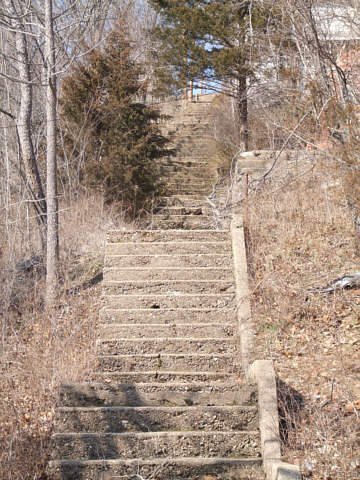 Looking up |
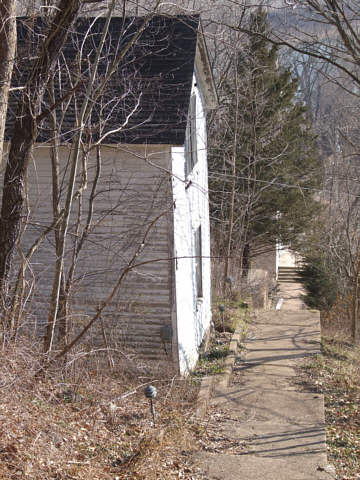 Looking down |
Tuscumbia, founded along the Osage River's banks, quickly spread up the adjoining hillside and split into four topographical regions. The top of the bluff, known as "Crackerneck," gave way to "The Hill", which in turn tumbled down to "Goose Bottom" and "Possum Flat" along the river's edge. The steps were built by residents to join the portion of the town on top of the hill with the older and lower section which flooded on a frequent basis.
Most people who have lived in Tuscumbia, or who have spent much time around the courthouse know about the steps which lead from the courthouse square down under the hill. For the most part they go unused, but years ago they saw a steady stream of foot traffic up and down them.
They were built around 1912 to 1915 and in their day were the main route of foot traffic from downtown Tuscumbia to the courthouse on the hill. Many people preferred the steps rather than struggle up the long steep hill. That slowly changed as the periodic floods on the Osage River prompted more and more businesses to move away from the waterfront.
Originally there were 112 steps from bottom to top but some were added when the circle drive was built around the courthouse sometime in the 1950s. Now 121 steps cover 290 feet up the hill.
There are 17 flights of steps, some breaking up badly and others damaged. Recently there has been talk of restoring this unique part of the Tuscumbia landscape.
TUSCUMBIA'S SISTER CITY----TWINS IN HISTORY
By Peggy Smith Hake
On the banks of the gently flowing Tennessee River, in northwestern Alabama, sits a lovely little city named Tuscumbia. Her history extends backward in time to the 18th century when a French colony established a trading post at the mouth of Spring Creek near present-day Tuscumbia. They traded with the Cherokees and Creek Indians of the region....the Chickasaw tribes were also nearby. The history of Tuscumbia, Alabama and Tuscumbia, Missouri are so near the same, it is almost bizarre, especially when you realize they are the only towns in America which bear the same unique Indian name.
Both towns came into existence when pioneers moved westward on the American frontier in the early 1800s. The first white settlers arrived at a big spring after traveling on a river....they found friendly Indian villages and began to trade with them....the settlements grew as trade began to expand on the river....the two towns had river landings that became major river ports.
Both of the counties, in which the two towns of Tuscumbia were located, were formed from larger counties named Franklin (Miller Co. was once a part of the huge land mass that belonged to Franklin County when Missouri was only a Territory).......Both towns became seats of government when the new counties formed and have remained so over the many years. The name Tuscumbia mean..."Warrior Who Kills" in the Chickasaw language and both towns were named for the Chickasaw Indian chief named Tuscumbia. It was originally spelled 'Taska-Ambi'. In the area of both towns are streams of water named Bear creek, Little Bear creek, and Dry creek.
The first settlers in Tuscumbia, Alabama were the family of Michael Dickson. Among Miller County's earliest settlers and merchants was a man named William P. Dixon/Dickson, whom historians say gave Tuscumbia, MO its name. Michael Dickson of Alabama was elected Clerk of the County Court in Franklin Co., AL and served 16 years. Wm. P. Dixon was the Clerk of the County Court and Circuit Court of Miller County, MO for 16 years. Mt. Pleasant was a trading area of early settlers in the area surrounding Tuscumbia, Alabama and Mt. Pleasant was the hub of activity of early trade in Miller County, Mo with Wm. P. Dixon being a merchant there.
It was on the 6th day of February 1837 that Miller County, MO was formed. On the 6th day of February (1867) Colbert County, AL was formed from Franklin Co., AL. Both towns of Tuscumbia remain county seats of government in their respective counties to this day.
NEEDLESS TO SAY, THE HISTORY OF THE TWO TUSCUMBIA'S SEEM TO HAVE BEEN CO-WRITTEN FROM THE SAME ORIGINAL MANUSCRIPT ! ! ! There are some differences in the two towns, as you might expect. Tuscumbia, AL was the site of America's first frontier railroad west of the Appalachian Mountains, called the Tuscumbia Railroad Co. and formed in 1830. It remained the center of wealth and culture before the Civil War and is one of the oldest towns in Alabama. Tuscumbia, MO never had a railroad through its town, but depended on the river traffic for imports and exports. Today, both towns have neither their railroad nor river trade in existence.
Tuscumbia, Alabama has a population of approximately 9,000 while Tuscumbia, Missouri's population is less than 500. The Alabama town is the birthplace of Helen Keller, America's "First Lady of Courage" (1880-1968). Heinie Manush, a famous American from the sports world, was also born in Tuscumbia, AL. He was a professional baseball player who is in the Baseball Hall of Fame at Cooperstown, NY. I can't recall any famous Americans hailing from Tuscumbia, MO, but I am sure we feel that our Tuscumbia natives are also special folks!
In 1991, I corresponded with Frank Ritchey, a teacher of history in the Tuscumbia, Alabama school system. His class was very interested in their "sister city", Tuscumbia, MO. Frank sent me a book called TUSCUMBIA, ALABAMA: AMERICA'S FIRST FRONTIER RAILROAD TOWN. I have donated this fine book to the Miller County Historical Society research library at Tuscumbia.